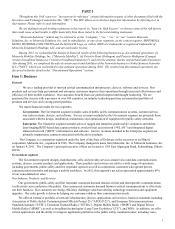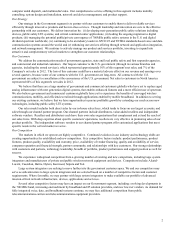Motorola 2012 Annual Report Download - page 19
Download and view the complete annual report
Please find page 19 of the 2012 Motorola annual report below. You can navigate through the pages in the report by either clicking on the pages listed below, or by using the keyword search tool below to find specific information within the annual report.11
significant cost and managerial time to prepare bids for contracts that may not be awarded to us. Even if we are awarded
contracts, we may fail to accurately estimate the resources and costs required to fulfill a contract, which could negatively
impact the profitability of any contract award to us. In addition, following a contract award, we have experienced and may
continue to experience significant expense or delay, contract modification or contract rescission as a result of customer delay or
our competitors protesting or challenging contracts awarded to us in competitive bidding.
We enter into fixed-price contracts that could subject us to losses in the event we fail to properly estimate our costs.
We enter into a number of firm fixed-price contracts. If our initial cost estimates are incorrect, we can lose money on
these contracts. Because many of these contracts involve new technologies and applications, require us to engage
subcontractors and can last multiple years, unforeseen events, such as technological difficulties, fluctuations in the price of raw
materials, problems with our subcontractors or suppliers and other cost overruns, can result in the contract pricing becoming
less favorable or even unprofitable to us and have an adverse impact on our financial results. In addition, a significant increase
in inflation rates could have a adverse impact on the profitability of longer-term contracts.
Government regulation of radio frequencies may limit the growth of public safety broadband systems or reduce barriers to
entry for new competitors.
Radio frequencies are required to provide wireless services. The allocation of frequencies is regulated in the U.S. and
other countries and limited spectrum space is allocated to wireless services and specifically to public safety users. The growth
of public safety broadband communications systems may be affected: (i) by regulations relating to the access to allocated
spectrum for public safety users, (ii) if adequate frequencies are not allocated, or (iii) if new technologies are not developed to
better utilize the frequencies currently allocated for such use. Industry growth may also be affected by new licensing fees
required to use frequencies.
The U.S. leads the world in allocating spectrum to enable wireless communications such as wireless local area network
systems, such as WiFi, mesh technologies and wide area network systems, such as WiMAX and LTE. Other countries have also
allocated spectrum to allow deployment of these and other technologies. This changing landscape may introduce new
competition and new opportunities for us.
The Middle Class Tax Relief and Job Creation Act of 2012 (the “Legislation”) authorized an additional ten MHz of
broadband spectrum for public safety use (the “D-block”) for a total of 20 MHz of contiguous broadband spectrum for public
safety. In addition, public safety retained 14 MHz of the 700 MHz narrowband spectrum, subject to the FCC's authority to
determine whether such spectrum should be authorized for future broadband use. The Legislation further provides for the
establishment of a centralized governance model through an independent authority within NTIA designated as the “First
Responder Network Authority” or “FirstNet” but allows for states to opt out of the plan to develop a nationwide public safety
network and perform their own competitive procurements if certain criteria are met. States that opt out would still be eligible
for funding and would also be allowed to generate revenue through leases to secondary users.
Although the Legislation has been enacted, the implementation of a nationwide public safety network under FirstNet
could be delayed or reduced significantly in scope due to: (i) complexities in the acquisition of a nationwide network, which
involves regulatory requirements, (ii) writing of the specifications and statement of work, (iii) decision making on the system
architecture or (iv) potential political opposition from certain states. Any such delays or changes in scope of the FirstNet
initiative could negatively impact our ability to further develop and expand our public safety LTE business. For example,
FirstNet may define specifications for the nationwide network which make it impossible or impractical for commercial LTE
infrastructure and equipment vendors to compete for contracts to build out the network. Furthermore, states may seek
alternative means to deploy public safety LTE networks if a centralized architecture inhibits states' ability to operationally
control its first responder agencies.
Our employees, customers, suppliers and outsource partners are located throughout the world and, as a result, we face risks
that other companies that are not global may not face.
Our customers and suppliers are located throughout the world. In 2012, more than 40% of our revenue was generated by
customers outside the U.S. In addition, we have a number of manufacturing, research and development, administrative and
sales facilities outside the U.S. and more than 50% of our employees are employed outside the U.S. Most of our suppliers'
operations are outside the U.S. and most of our products are manufactured outside the U.S.
Because we have sizeable sales and operations outside the U.S., including outsourcing and procurement arrangements
outside of the U.S., we have more complexity in our operations and are exposed to a unique set of global risks that could
negatively impact sales or profitability, including but not limited to: (i) import/export regulations, tariffs, trade barriers and
trade disputes, customs classifications and certifications, including but not limited to changes in classifications or errors or
omissions related to such classifications and certifications; (ii) changes in U.S. and non-U.S. rules related to trade,
environmental, health and safety, technical standards and consumer protection; (iii) longer payment cycles; (iv) tax issues, such
as tax law changes, variations in tax laws from country to country and as compared to the U.S., obligations under tax incentive
























